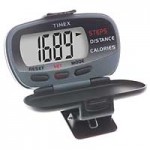Maybe you have heard the recent guidelines about walking 10,000 steps per day. How far is 10,000 steps anyway? The average person’s stride length is approximately 2.5 feet long. That means it takes just over 2,000 steps to walk one mile, and 10,000 steps is close to 5 miles.
Unless you have an active job such as a waitress or nurse, a sedentary person may only average 1,000 to 3,000 steps a day. For these people adding steps has many health benefits. I have outlined the basic 10,000 steps program, but also added a commentary below.
A reasonable goal for most people is to increase average daily steps each week by 500 per day until you can easily average 10,000 per day. Example:Â If you currently average 3000 steps each day, your goal for week one is 3500 each day. Your week 2 goal is 4000 each day. Continue to increase each week and you should be averaging 10,000 steps by the end of 14 weeks. Most people achieve it by one or more sustained walks or runs, equivalent to 30-60 minutes or more of walking per day. That equals the minimum daily exercise recommendation by the CDC.
Wearing a pedometer is an easy way to track your steps each day. Start by wearing the pedometer every day for one week. Put it on when you get up in the morning and wear it until bed time. Record your daily steps in a log or notebook. By the end of the week you will know your average daily steps. You might be surprised how many (or how few) steps you get in each day.
With childhood obesity skyrocketing in countries around the world, researchers asked how much activity a child needs to be in a healthy body composition zone. Pedometers easily measure how much a child is moving between activities and play, and these “lifestyle steps” can be enough to keep a child in a healthy weight zone.
How Many Steps a Child Needs
Studies showed that for 6–12 year olds, girls needed 12,000 steps/day and boys needed 15,000 steps/day to stay in a healthy Body Mass Index – BMI. The study reviewed research of almost 2000 children in the USA, Australia, and Sweden. The study was published in the June, 2004 “Preventative Medicine” by Catrine Tudor-Locke Ph.D. and associates.
There are many ways to increase your daily steps. Use your imagination and come up with your own list:
- Take a walk with your spouse, child, or friend
- Walk the dog
- Use the stairs instead of the elevator
- Park farther from the store
- Better yet, walk to the store
- Get up to change the channel
- Window shop
- Plan a walking meeting
- Walk over to visit a neighbor
- Get outside to walk around the garden or do a little weeding
Continue to track your daily steps and/or mileage; and keep notes on how you feel, how your body is improving, or other changes you are making to improve your health.
If You Continue to Gain Weight, Add More Steps
If you are already logging 10,000 steps a day and gaining weight or not losing weight, then the key is to add another 2,000 steps per day (and/or eat fewer calories). If that still does not work after a couple of weeks, add more steps or eat less. Each 2,000-2,500 steps is about a mile, or 100 calories for a 150-pound person.
I Hate to Walk, But I Like To ….
 If you really can’t stand to walk but you like to jog or run — Go ahead and get your steps in with jogging or running. A pedometer can track your steps whether you are moving slow or fast. If you use special exercise equipment or if you like to bicycle, swim or kayak, we discovered our pedometer does not help us keep track of our activity. Even on a stair stepper or stair climber in the gym, it was not accurate. But not to worry, you can “translate†your 10,000 step goal into an equivalent time goal for your favorite activity.
If you skip exercise continuously for a few days, you will discover it is a downward spiral. The more days you skip, the more likely you will abandon your program altogether. If you can get back in the groove and exercise two days in a row, you will discover that the third day of exercise will be easier to achieve.
If you are in very poor physical condition or at any point you feel that you are progressing too rapidly slow down a bit and try smaller increases. If you have any health concerns seek your physician’s advice prior to starting or changing your exercise routine. You will also need a good pair of sneakers. A running shoe with plenty of cushion is actually more preferred. Sneakers have been known to wear out after six months or so and they have to be replaced.



